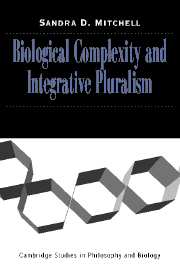5 - Laws
Published online by Cambridge University Press: 05 June 2012
Summary
The argument of this book is that complexity in nature, particularly in biological nature, has direct implications for our scientific theories, models, and explanations. In other words, nature is complex and so, too, should be our representations of it. One feature of this corresponding complexity of representations is pluralism, in contrast to unity of scientific constructions. For example, not all apparently similar phenotypes will have the same explanation. Selection operating at different levels may produce the same outcome; we cannot reduce selection theory to a single unit or level. Multiple causal components operating simultaneously contribute to biological traits such as complex behaviors; we should not expect a single cause, natural selection, to explain all that we observe. And interactions among parts of complex wholes generate order by the dynamics of their interactions; we should not anticipate simple, linear models to account for the structure and behavior of such systems. In short, the multilevel, multicomponent, complex systems that populate the domain of biology are ill suited to a simple, unified picture of scientific theorizing. Pluralism in this domain is not an embarrassment of an immature science, but the mark of a science of complexity.
A notorious example of the mismatch between the expectations of a reductive unificationist and the practices of biologists is the absence of biological laws. Universal, exceptionless laws have been taken to be the hallmark of successful science.
- Type
- Chapter
- Information
- Biological Complexity and Integrative Pluralism , pp. 115 - 178Publisher: Cambridge University PressPrint publication year: 2003
- 1
- Cited by

